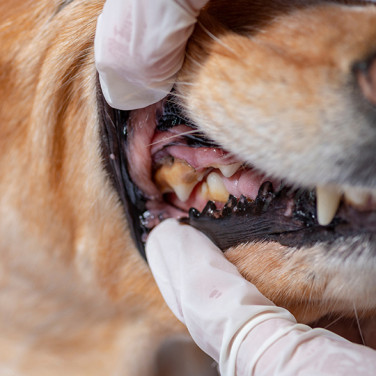DISEASES
Pyometra in Dogs - Symptoms of Infection in Dog’s Uterus
페이지 정보
본문


What is pyometra in dogs?
Pyometra is a uterine disease that occurs mainly in middle-aged to elderly unneutered female dogs. It is a condition in which purulent material accumulates in the uterus due to a bacterial infection. Pyometra is a serious, life-threatening disease that requires prompt treatment.
Pyometra is caused by ongoing hormonal cycle changes in unneutered female dogs. The endometrium, the inner lining of the uterus, thickens in preparation for conception for 8 to 10 weeks after estrus in female dogs. If this process is repeated, permanent changes such as cystic endometrial hyperplasia can occur, in which the uterine tissue thickens. When the uterus becomes thick, the muscles of the uterus do not contract properly, making it difficult to discharge bacteria and creating an environment in which bacteria can grow.

Pyometra usually can occur 2 to 8 weeks after estrus, when the uterus is most vulnerable to infection. The cervix, the entrance to the uterus, is closed outside of estrus, so bacteria cannot enter. However, during estrus, the cervix opens, allowing bacteria to enter the uterus. Even if bacteria enter the uterus, it is generally difficult for them to multiply. However, changes such as cystic endometrial hyperplasia create an environment in which bacteria can thrive, resulting in pyometra.
Causes of pyometra in dogs
Pyometra occurs when the cervix opens during estrus, allowing bacteria to invade and proliferate in the endometrium, leading to the growth of bacteria.
The causes of pyometra in dogs are those that cause these changes during estrus.
- Normally repeated estrus process
- Hormonal drugs (ex. Estrogen, Progesterone) for the treatment of other diseases such as genital disorders.
Symptoms of pyometra in dogs
The presence and severity of symptoms of canine pyometra vary based on whether the cervix is open or closed. If the cervix is closed, more serious symptoms may occur because toxins secreted by bacteria in the uterus can spread throughout the body through the blood.
Common symptoms of a canine pyometra:
- Anorexia
- Vomiting/diarrhea
- Lethargy
- Depression
- Increased thirst/increased urination
- Fever
- Abdominal distension
- Vulvar discharge like pus (When the cervix is open)
Pyometra is considered a medical emergency in dogs
Pyometra is a fatal emergency for your dog's health. In the early stages, symptoms may be mild and vague. However, if symptoms like polyuria or fever appear within 2 to 8 weeks after the most recent estrous period, it is important to take your dog to the hospital for testing. If left untreated, the toxins secreted by the bacteria can spread throughout the body through the bloodstream.

What if I suspect my dog has pyometra? Are there any home treatments for pyometra in dogs?
If a dog's pyometra is suspected, there is no temporary treatment that the guardian can give at home. It should be considered an emergency and the hospital should be visited as soon as possible for treatment.
What is the diagnosis process like for pyometra in dogs?
If you visit the hospital with symptoms of pyometra, the veterinarian will ask you a number of questions to accurately determine your pet's condition. Based on your answers, the veterinarian may perform additional tests necessary for appropriate treatment and accurate diagnosis.
Questions your veterinarian may ask include:
- When was the last heat?
- What are the symptoms and when did they start?
- Has your dog taken any medications recently?
- Is there a pus-like exudate coming out of the vagina?
Based on the guardian's answers, the following tests may be conducted for an accurate diagnosis.
-
Physical examination
Check for current dehydration and perform basic physical tests, such as checking the heart rate and respiratory rate.
-
Blood test
In general, if your dog has pyometra, their white blood cell count will be severely increased and there will also be an increase in globulin, a protein associated with bacterial infection. Severe symptoms may be accompanied by changes in various levels, including electrolytes, blood sugar, kidney, and liver levels.
-
X-ray
X-rays are used to check the enlarged uterus, but depending on the degree of change, it may or may not be noticeable.
-
Ultrasound
An accurate examination through ultrasound is performed when it is not clearly identified on radiographs or when additional discernment is needed, such as during normal pregnancy. Ultrasound can be used to evaluate changes in the size of the uterus, the thickness of the uterine wall, and the amount of exudate accumulation in the uterus.
What is the treatment process for pyometra in dogs?
Pyometra surgery and treatment plans are established with the veterinarian, taking into consideration the dog's current health condition and breeding plan.
-
Surgical treatment
Pyometra is usually treated by removing the ovaries and uterus through a surgical method called ovarian hysterectomy. If diagnosed early and surgically removed, the prognosis is usually very good. However, the prognosis can be poor if the cervix is closed and pus continues to accumulate in the uterus until it ruptures, allowing bacteria and purulent material to spread into the abdominal cavity.
- An ovarian hysterectomy is a surgical procedure used for spaying, but it is more complicated than a standard spaying procedure. Pyometra is often diagnosed when symptoms are evident and painful, and additional pain management, antibiotic treatment, or fluid treatment may be necessary. Depending on the condition, hospitalization may be required.
-
Medication
For reproductive purposes, there may be instances where drug treatment is used in addition to surgical methods to preserve the uterus. Prostaglandin, a drug used to treat pyometra, lowers the level of a hormone that thickens the uterine wall, opens the cervix, and contracts the uterus. While medications can help drain pus and bacteria from the uterus, it is important to note that responses to treatment may vary and can come with long-term complications such as infertility, uterine rupture, pain, and vomiting. In situations where the symptoms are severe, it may be necessary to proceed with immediate surgery rather than drug treatment.
How to prevent pyometra in dogs
The only way to prevent pyometra is to have your dog spayed. In general, if your dog is spayed before its first heat, the incidence of breast cancer is also significantly lower. Therefore, if you do not have breeding plans for your dog, it is recommended to have it spayed before this time. However, even if your dog has had heat, a spay surgery can still be done at any time to prevent pyometra.
The surgical method for removing the uterus and ovaries is the same whether it is for spaying or treating pyometra. However, it is much safer and cheaper to have the spay surgery when the animal is healthy, so if breeding is not in the plans, it is best to have the surgery at a young age.
Find out more about your dog’s condition or symptoms in the Buddydoc Library!

The Buddydoc library is filled with everything you’d want to know about each symptom and disease your pet may experience. If you would like to find out more about the causes, signs, treatments, preventions, and more for your dog’s condition. Try out the Buddydoc app and search your pet’s symptom or condition in the Buddydoc library.












